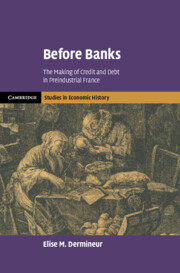Refine search
Actions for selected content:
26945 results in Economic history
Map of Roman Italy
-
- Book:
- Wealth, Office and Rank in Roman Italy
- Published online:
- 23 July 2025
- Print publication:
- 17 July 2025, pp xiii-xiii
-
- Chapter
-
- You have access
- Open access
- Export citation
Appendix B - Dataset: Alimenta Pledges
-
- Book:
- Wealth, Office and Rank in Roman Italy
- Published online:
- 23 July 2025
- Print publication:
- 17 July 2025, pp 228-241
-
- Chapter
-
- You have access
- Open access
- Export citation
3 - Reconstructing Historical Wealth Distributions
-
- Book:
- Wealth, Office and Rank in Roman Italy
- Published online:
- 23 July 2025
- Print publication:
- 17 July 2025, pp 40-61
-
- Chapter
-
- You have access
- Open access
- Export citation
8 - Wealth Inequality among Italian Elites
-
- Book:
- Wealth, Office and Rank in Roman Italy
- Published online:
- 23 July 2025
- Print publication:
- 17 July 2025, pp 144-155
-
- Chapter
-
- You have access
- Open access
- Export citation
Introduction
-
- Book:
- Wealth, Office and Rank in Roman Italy
- Published online:
- 23 July 2025
- Print publication:
- 17 July 2025, pp 1-11
-
- Chapter
-
- You have access
- Open access
- Export citation
List of Abbreviations
-
- Book:
- Wealth, Office and Rank in Roman Italy
- Published online:
- 23 July 2025
- Print publication:
- 17 July 2025, pp xvi-xvi
-
- Chapter
-
- You have access
- Open access
- Export citation
Appendix C - Dataset: Ostian Burial Plots
-
- Book:
- Wealth, Office and Rank in Roman Italy
- Published online:
- 23 July 2025
- Print publication:
- 17 July 2025, pp 242-258
-
- Chapter
-
- You have access
- Open access
- Export citation
5 - The Heterogeneity of the Italian Civitates
-
- Book:
- Wealth, Office and Rank in Roman Italy
- Published online:
- 23 July 2025
- Print publication:
- 17 July 2025, pp 93-106
-
- Chapter
-
- You have access
- Open access
- Export citation
Index
-
- Book:
- Wealth, Office and Rank in Roman Italy
- Published online:
- 23 July 2025
- Print publication:
- 17 July 2025, pp 284-288
-
- Chapter
-
- You have access
- Open access
- Export citation
Frontmatter
-
- Book:
- Wealth, Office and Rank in Roman Italy
- Published online:
- 23 July 2025
- Print publication:
- 17 July 2025, pp i-iv
-
- Chapter
-
- You have access
- Open access
- Export citation
4 - Wealth and Political Office at Pompeii
-
- Book:
- Wealth, Office and Rank in Roman Italy
- Published online:
- 23 July 2025
- Print publication:
- 17 July 2025, pp 62-92
-
- Chapter
-
- You have access
- Open access
- Export citation
List of Tables
-
- Book:
- Wealth, Office and Rank in Roman Italy
- Published online:
- 23 July 2025
- Print publication:
- 17 July 2025, pp xi-xii
-
- Chapter
-
- You have access
- Open access
- Export citation

Before Banks
- The Making of Credit and Debt in Preindustrial France
-
- Published online:
- 27 June 2025
- Print publication:
- 23 January 2025
Index
-
- Book:
- Institutional Genes
- Published online:
- 03 June 2025
- Print publication:
- 26 June 2025, pp 757-773
-
- Chapter
- Export citation
13 - The Post-Mao Reform and Its Cessation
-
- Book:
- Institutional Genes
- Published online:
- 03 June 2025
- Print publication:
- 26 June 2025, pp 594-657
-
- Chapter
- Export citation
Figures
-
- Book:
- Institutional Genes
- Published online:
- 03 June 2025
- Print publication:
- 26 June 2025, pp xiv-xiv
-
- Chapter
- Export citation
11 - Building a Totalitarian Regime
-
- Book:
- Institutional Genes
- Published online:
- 03 June 2025
- Print publication:
- 26 June 2025, pp 499-542
-
- Chapter
- Export citation
Dedication
-
- Book:
- Institutional Genes
- Published online:
- 03 June 2025
- Print publication:
- 26 June 2025, pp vii-viii
-
- Chapter
- Export citation
12 - Regionally Administered Totalitarianism
-
- Book:
- Institutional Genes
- Published online:
- 03 June 2025
- Print publication:
- 26 June 2025, pp 543-593
-
- Chapter
- Export citation
Preface and Acknowledgments
-
- Book:
- Institutional Genes
- Published online:
- 03 June 2025
- Print publication:
- 26 June 2025, pp xv-xxii
-
- Chapter
- Export citation
